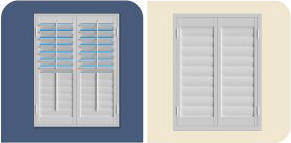
3 Ways Polywood Shutters Are Better Than Hollow Vinyl And Composite Shutters In Houston, TX
December 15, 2015
The market for plantation shutters in Houston is full of options. And when you are figuring out which non-wood shutter fits your home best, some differences may be tough to recognize. You can easily make the wrong choice and end up investing in low quality shutters. Wondering if Polywood® shutters - our best-selling solid polymer shutters - are a better investment than MDF (multi-density fiberboard) or hollow vinyl shutters? Here are three ways Polywood shutters are better than composite shutters in Houston, TX so you can choose.
1. Polywood vs Composite Shutters Durability
Polywood shutters are constructed from a first class solid polymer that ensures the most rigidity, color-retention, and durability than any other shutter money can buy. With that, the shutter louvers will not chip as time goes by. However, composite shutters are made from a pressed-board core, wrapped with poly-vinyl. The vinyl wrapping the pressed board also peels away from the core material readily. And this peeling happens even faster in wet, hot, and humid environments. Hollow vinyl shutters are another option for non-wood shutters. But they disintegrate the fastest in large part due to the elements.Both kinds of non-wood shutters are likely to warp and deteriorate under varying weather conditions in Houston. Polywood is manufactured with UV inhibitors that do not absorb heat. And because heat is the leading culprit in warping the shutter louvers, Polywood is absolutely the longest lasting plantation shutter for your home.
2. Polywood vs Composite Shutters Color Fastness
Polywood shutters colors include three premium white paints. We bake these paint finishes on each piece at temperatures hotter than it will ever get in Houston, TX. This patented finishing process uses UV inhibitors and ensures the color will never fade.
Other types of non-wood shutters are available in low quality paint finish. And some composite shutters won’t even have any paint finish at all. In the majority of cases, the vinyl layer is the final color. Although it looks good when installed, this finish fades over time. And some hollow vinyls are painted. With the vinyl being a heat conductor, this adversely affects the finish as time goes by.
3. Polywood vs Composite Shutters Energy Efficiency
Third party testing shows that Polywood shutters shield against 30° of temperature and result in a reduction of heat transfer by up to 45%. This means that Polywood insulates up to 70% better than the top solid wood shutter.
Polywood’s insulating properties are a result of the solid polymer material. Yet what sets Polywood apart even more from composite shutters is the weatherstripping on the panels and louvers. Just interlock the pieces of weatherstripping when closing the panels and you get the tightest seal possible against the impact of the weather outside. No composite shutter can offer the energy savings that Polywood does.
The Sunburst Team In Vegas Puts The Durability Of Polywood Shutters To The Test
In 2004, Sunburst Shutters Las Vegas had Polywood shutters attached to the sides of their trucks as part of the graphics. They were parked outside and withstood all the weather conditions Vegas is infamous for. We’re talking extreme heat for five months out of the year!
Those Polywood shutters had been fastened to our trucks for almost 7 years. Our team conducted a test on the color retention value of Polywood. The team wiped down the dusty Polywood shutter installed on the vehicle. And we compared it side by side to a new Polywood. We found the color to be unchanged. There wasn’t any visible signs of fading or discoloration. This was further validation for the team that our paint finish is indeed the best around!
And with Polywood withstanding that much heat and abuse on the road for 7+ years, it’s without a doubt the long lasting shutter for your home in Houston, TX.


